Atlassian Bundle
How Did Atlassian Revolutionize Teamwork?
Ever wondered how a company born in Sydney, Australia, became a global force in software? Atlassian's story is one of innovation, starting with a simple mission to empower software developers with affordable tools. From its early days focusing on issue tracking, the company rapidly expanded, forever changing how teams collaborate and manage projects.
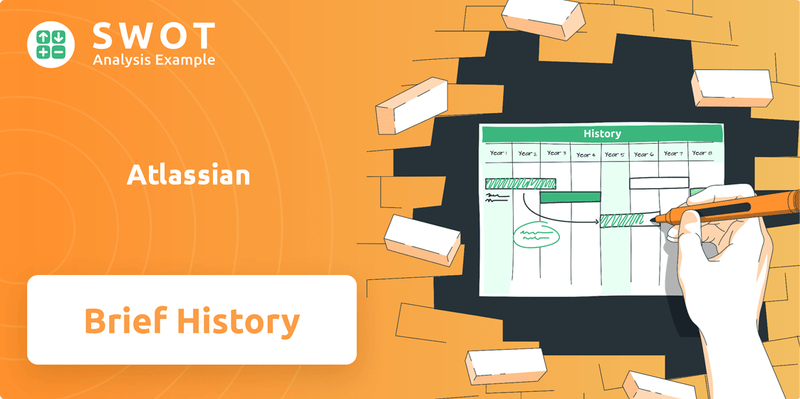
This Atlassian SWOT Analysis will explore the Atlassian history, from its inception in 2002 to its current status as a leading provider of team collaboration software. We'll trace the Atlassian company’s Atlassian timeline, highlighting key milestones, including the Atlassian founders’ vision and the evolution of Atlassian products like Jira and Confluence. Discover the Atlassian acquisitions that fueled its growth and shaped its impact on modern work methodologies, offering a comprehensive overview of how Atlassian became a multi-billion dollar enterprise.
What is the Atlassian Founding Story?
The Atlassian company was born on October 2, 2002. The company's story began with two university friends from Sydney, Australia: Mike Cannon-Brookes and Scott Farquhar. Their goal was to create software that would help teams collaborate more effectively, a concept that was not fully addressed by existing enterprise software solutions.
They identified a gap in the market for affordable, high-quality software development tools. The founders aimed to make project management and issue tracking software accessible to smaller teams and startups. Their approach was to offer powerful software at a lower cost, distributed online, which was innovative for enterprise software at the time.
The initial product was Jira, an issue-tracking system designed to help software developers manage bugs and project tasks efficiently. They bootstrapped the company, funding it through credit card debt. This approach allowed them to maintain control over their vision and development. The name 'Atlassian' was chosen to symbolize their commitment to supporting teamwork.
The early days of Atlassian history involved bootstrapping and a focus on a specific market need.
- The company was founded in 2002.
- The initial focus was on issue-tracking and project management software.
- They used credit card debt to fund the company, maintaining control.
- The name 'Atlassian' reflects their mission to support teamwork.
Atlassian's early growth was marked by a focus on providing accessible and effective software solutions. Their initial success with Jira laid the groundwork for future products and acquisitions. The company's commitment to its original vision, combined with a keen understanding of market needs, drove its early expansion. The company's approach to software distribution, offering online solutions, was a key factor in its early success. Atlassian's ability to address the needs of software development teams and startups set it apart from competitors. For more insights into how Atlassian approaches its market, you can read about the Marketing Strategy of Atlassian.
Atlassian SWOT Analysis
- Complete SWOT Breakdown
- Fully Customizable
- Editable in Excel & Word
- Professional Formatting
- Investor-Ready Format
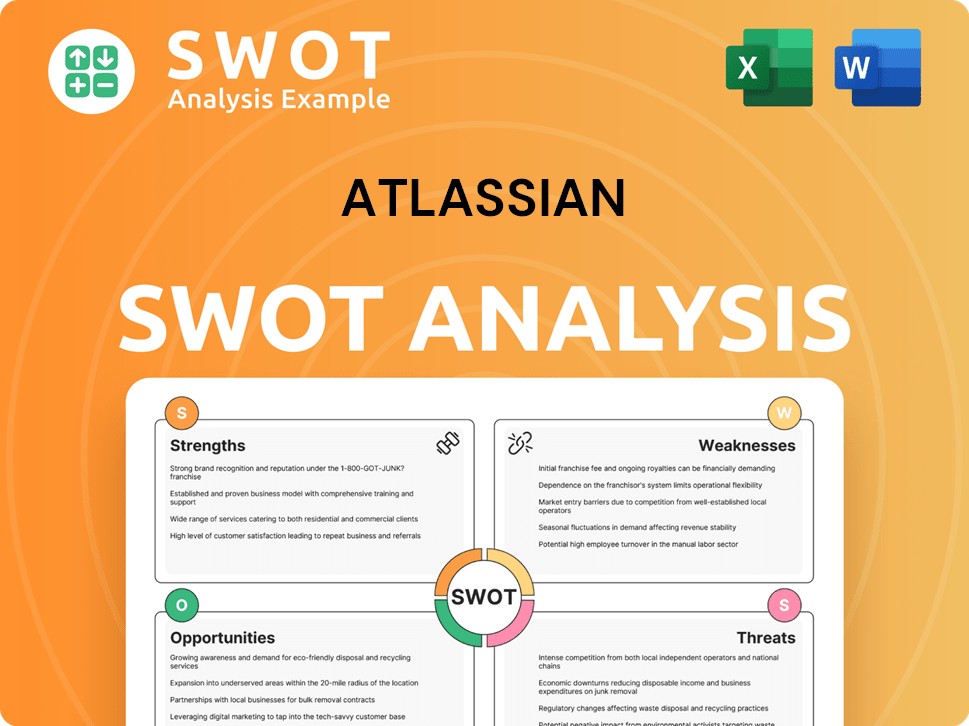
What Drove the Early Growth of Atlassian?
The early growth of the company was marked by a strong emphasis on product development and organic adoption, primarily driven by the quality and affordability of Jira. This approach allowed the company to efficiently reach a global customer base. This initial success led to the expansion of their product suite, and Atlassian continued to grow. Focusing on developer tools and team collaboration, the company carved out a distinct niche in the enterprise software market.
The company's initial success was largely attributed to Jira, a project management and issue tracking tool. This product's quality and accessible pricing model were key factors in attracting early customers. This focus on a specific product helped establish the company in the market, setting the stage for future expansion and the development of additional products.
The company utilized a unique online distribution model. This approach bypassed traditional sales channels, enabling the company to reach a global customer base efficiently. This strategy was particularly effective in the early days, allowing the company to scale rapidly and gain traction in various markets. This also helped in the early Atlassian's mission.
In 2004, the company launched Confluence, a team collaboration and knowledge management platform. This addition further solidified their position in the team productivity space. The expansion into new product areas demonstrated the company's ability to adapt to market needs and provide comprehensive solutions for its customers. This helped with the company's growth trajectory.
In 2007, the company received its first significant external investment of $60 million from Accel Partners. This funding supported further product innovation, including the acquisition of Bitbucket in 2010, a Git code management solution. These strategic moves expanded their offerings and broadened their appeal to developers, which shaped the Atlassian company history overview.
Atlassian PESTLE Analysis
- Covers All 6 PESTLE Categories
- No Research Needed – Save Hours of Work
- Built by Experts, Trusted by Consultants
- Instant Download, Ready to Use
- 100% Editable, Fully Customizable
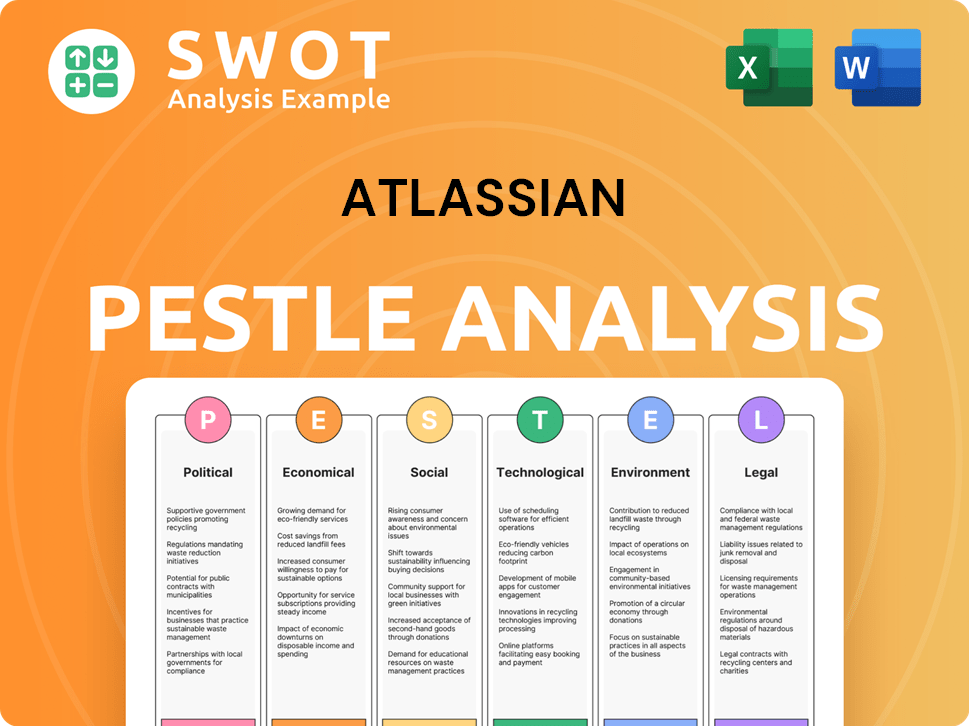
What are the key Milestones in Atlassian history?
The Atlassian company has a rich history, marked by key milestones and significant growth in the collaborative software space. From its early days to its current status as a leading provider, the company's journey reflects its commitment to innovation and strategic expansion.
| Year | Milestone |
|---|---|
| 2002 | Launch of Jira, establishing a core offering for issue tracking. |
| 2004 | Introduction of Confluence, expanding into team collaboration and content management. |
| 2010 | Acquisition of Bitbucket, broadening the portfolio to include code management solutions. |
| 2017 | Acquisition of Trello, expanding into visual project management. |
| 2015 | Atlassian went public, trading on the NASDAQ under the ticker TEAM. |
| 2024 | Atlassian continues to innovate, with a focus on cloud-based solutions and AI integrations. |
The company's innovative approach included a transparent, low-cost licensing model and online distribution, disrupting the traditional enterprise software market. Atlassian's strategic acquisitions, such as Bitbucket and Trello, showcase its commitment to expanding its product offerings and meeting evolving customer needs.
Atlassian revolutionized the software market with its affordable and transparent licensing. This approach made its products accessible to a wider range of users, from startups to large enterprises.
The launch of Jira in 2002 was a pivotal moment, establishing Atlassian as a key player in issue tracking. Jira quickly became a go-to solution for software development teams worldwide.
Confluence, launched in 2004, expanded Atlassian's offerings into team collaboration and content management. It provided teams with a centralized hub for sharing knowledge and working together.
The acquisition of Bitbucket in 2010 marked Atlassian's entry into code management. This move strengthened its position in the developer tools market.
Atlassian acquired Trello in 2017, expanding its portfolio with a popular visual project management tool. This allowed Atlassian to cater to a broader audience and enhance its project management capabilities.
Atlassian has increasingly focused on cloud-based solutions to meet the growing demand for accessible and scalable software. This shift has enabled greater flexibility and collaboration for users.
Despite its successes, Atlassian has faced challenges, including competition from larger enterprise software vendors and the need to maintain product-market fit. Scaling its cloud infrastructure to meet the demands of millions of users has been a significant technical hurdle.
Atlassian competes with established enterprise software vendors and agile project management tool providers. Staying ahead in this competitive market requires continuous innovation and strategic adaptation.
Maintaining product-market fit across an expanding suite of tools and diverse customer needs is an ongoing challenge. Atlassian must ensure its products meet the evolving demands of its user base.
Scaling cloud infrastructure to support millions of users and ensure seamless integration across its product ecosystem is a significant technical challenge. This requires continuous investment in infrastructure and development.
Ensuring seamless integration across its diverse product ecosystem can be complex. Atlassian must continuously work to improve the interoperability of its tools to provide a cohesive user experience.
Adapting to the evolving needs of its diverse customer base is crucial for Atlassian's continued success. This requires a deep understanding of user requirements and a commitment to innovation.
The software market is constantly evolving, and Atlassian must adapt to shifts in technology and user preferences. This includes embracing new technologies like AI and focusing on cloud-based solutions.
Atlassian Business Model Canvas
- Complete 9-Block Business Model Canvas
- Effortlessly Communicate Your Business Strategy
- Investor-Ready BMC Format
- 100% Editable and Customizable
- Clear and Structured Layout
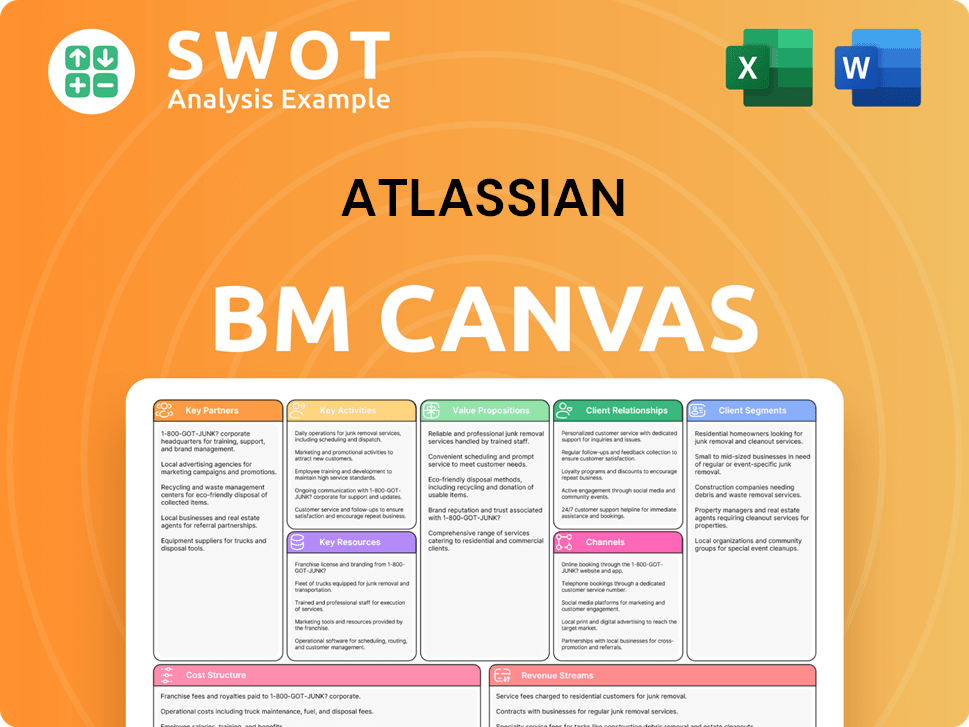
What is the Timeline of Key Events for Atlassian?
The Atlassian company's journey is marked by significant milestones that have shaped its evolution and impact on the software industry. From its inception in Sydney, Australia, to its current status as a global leader in collaboration software, Atlassian's history reflects a commitment to innovation and strategic growth. This Atlassian timeline highlights key events that have defined the company's trajectory, including product launches, strategic acquisitions, and its public listing on NASDAQ.
| Year | Key Event |
|---|---|
| October 2, 2002 | Atlassian founders Mike Cannon-Brookes and Scott Farquhar established the company in Sydney, Australia. |
| 2002 | Jira, the first product, was launched, designed for issue tracking. |
| 2004 | Confluence, a platform for team collaboration and knowledge sharing, was released. |
| 2007 | Accel Partners provided the first significant external investment of $60 million. |
| 2010 | Bitbucket, a Git code management solution, was acquired. |
| 2012 | Atlassian Marketplace, an ecosystem for third-party add-ons, was launched. |
| 2015 | The company went public on NASDAQ under the ticker TEAM. |
| 2017 | Trello, a popular visual project management tool, was acquired. |
| 2020 | A shift to a cloud-first strategy was announced, phasing out server products. |
| 2023 | Atlassian reported a strong Q3 FY23 with total revenue increasing 24% year-over-year to $915 million. |
| 2024 | The company is focused on cloud migration and AI integration across its product suite. |
Atlassian's future is heavily focused on expanding its cloud offerings. The company is actively migrating its server customers to cloud solutions, anticipating significant growth in cloud revenue. This strategic shift is designed to provide more scalable and accessible solutions for its global customer base. This move is expected to drive long-term value and enhance user experience.
Atlassian is integrating AI capabilities into its core products, such as Jira and Confluence. These enhancements aim to provide intelligent automation, deeper insights, and personalized user experiences. AI integration is a key strategy to improve productivity and streamline workflows for teams. The company's investments in AI are expected to drive innovation.
Atlassian is targeting the enterprise market with more robust security, compliance, and scalability features. This focus aims to attract larger organizations seeking comprehensive collaboration solutions. The company is investing in features that meet the complex needs of large enterprises. Strategic initiatives are designed to capture a larger share of the enterprise market.
The collaborative software market is expected to continue growing, driven by remote and hybrid work models. Atlassian is well-positioned to capitalize on this trend. The company's leadership consistently emphasizes empowering teams to work more effectively. For a deeper dive, you can explore more about Atlassian's journey in this detailed analysis: Atlassian's growth trajectory.
Atlassian Porter's Five Forces Analysis
- Covers All 5 Competitive Forces in Detail
- Structured for Consultants, Students, and Founders
- 100% Editable in Microsoft Word & Excel
- Instant Digital Download – Use Immediately
- Compatible with Mac & PC – Fully Unlocked
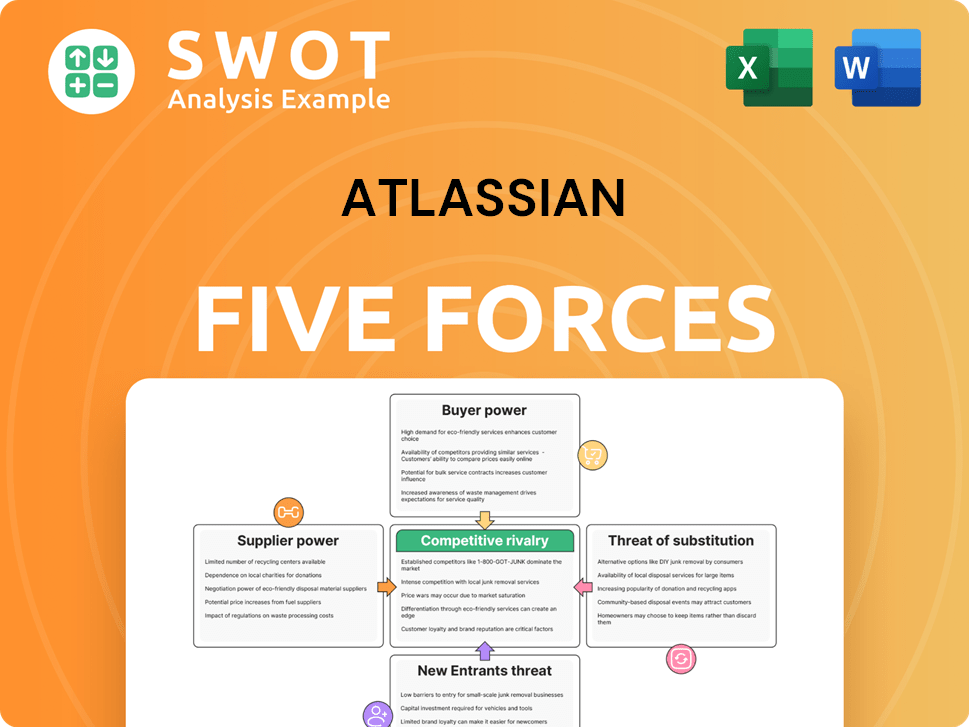
Related Blogs
- What is Competitive Landscape of Atlassian Company?
- What is Growth Strategy and Future Prospects of Atlassian Company?
- How Does Atlassian Company Work?
- What is Sales and Marketing Strategy of Atlassian Company?
- What is Brief History of Atlassian Company?
- Who Owns Atlassian Company?
- What is Customer Demographics and Target Market of Atlassian Company?
Disclaimer
All information, articles, and product details provided on this website are for general informational and educational purposes only. We do not claim any ownership over, nor do we intend to infringe upon, any trademarks, copyrights, logos, brand names, or other intellectual property mentioned or depicted on this site. Such intellectual property remains the property of its respective owners, and any references here are made solely for identification or informational purposes, without implying any affiliation, endorsement, or partnership.
We make no representations or warranties, express or implied, regarding the accuracy, completeness, or suitability of any content or products presented. Nothing on this website should be construed as legal, tax, investment, financial, medical, or other professional advice. In addition, no part of this site—including articles or product references—constitutes a solicitation, recommendation, endorsement, advertisement, or offer to buy or sell any securities, franchises, or other financial instruments, particularly in jurisdictions where such activity would be unlawful.
All content is of a general nature and may not address the specific circumstances of any individual or entity. It is not a substitute for professional advice or services. Any actions you take based on the information provided here are strictly at your own risk. You accept full responsibility for any decisions or outcomes arising from your use of this website and agree to release us from any liability in connection with your use of, or reliance upon, the content or products found herein.